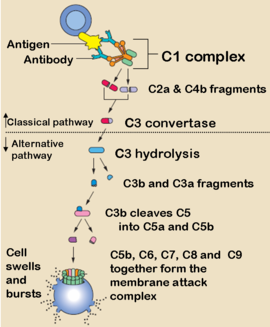
C3-convertase
Encyclopedia

- The first is an enzymeEnzymeEnzymes are proteins that catalyze chemical reactions. In enzymatic reactions, the molecules at the beginning of the process, called substrates, are converted into different molecules, called products. Almost all chemical reactions in a biological cell need enzymes in order to occur at rates...
composed of the C4b-C2a complex, which forms during the classicalClassical complement pathwayThe Classical pathway of activation of the complement system is a group of blood proteins that mediate the specific antibody response. The main activators of the Classical Pathway are antigen-antibody complexes.-Initiation:...
or lectinMannan-binding lectin pathwayThe Mannan-binding lectin pathway is similar in structure to the classical complement pathway, in that, after activation, it proceeds through the action of C4 and C2 to produce activated complement proteins further down the cascade...
pathways of the complement systemComplement systemThe complement system helps or “complements” the ability of antibodies and phagocytic cells to clear pathogens from an organism. It is part of the immune system called the innate immune system that is not adaptable and does not change over the course of an individual's lifetime...
. It is formed when C1sC1SComplement C1s subcomponent is a protein that in humans is encoded by the C1S gene.-Interactions:C1S has been shown to interact with C1R.-Further reading:...
cleaves off a small peptide fragment of C2 C2bComplement component 2Complement C2 is a protein that in humans is encoded by the C2 gene. The protein encoded by this gene is part of the classical pathway of complement system.-Further reading:...
from a membrane-bound C4b-C2a complex.
- The second consists of the C3bC3bC3b is the larger of two elements formed by the cleavage of complement component 3. C3b covalently bonds to microbial cell surfaces within an organism's body. This leads to the production of surface-bound C3 convertase and thus more C3b components. Bound C3b also aids in opsonization of the microbe...
Bb complex, which forms during the alternative complement pathwayAlternative complement pathwayThe alternative pathway of the complement system is an innate component of the immune system's natural defense against infections, which can operate without antibody participation....
. It is formed when membrane-bound C3b binds to factor B, which is, in turn, cleaved by factor D into Ba and Bb. Bb remains bound to C3b while Ba is released into the surrounding medium.
Once formed, both C3-convertases will catalyze the proteolytic cleavage of C3
C3 (complement)
Complement component 3, often simply called C3, is a protein of the immune system. It plays a central role in the complement system and contributes to innate immunity. In humans it is encoded on chromosome 19 by a gene called C3.-Function:...
into C3a and C3b (hence the name "C3-convertase"). C3b can then act as an opsonizer or bind to activated bimolecular complex C4b2a to form a trimolecular complex, C5-convertase, which is a specific enzyme for C5.
A convertase (of either type) with an additional 3b (C4b2a3b or C3bBb3b) is known as "C5-convertase
C5-convertase
C5-convertase is an enzyme involved in the complement system. Its primary function is to cleave C5 protein to C5a and C5b. C5a is a smaller product and diffuses into the plasma, whereas C5b remains and initiates the formation of membrane attack complex .There are two forms of C5-convertase, one...
".
C3 convertase is, in classical terms, C4b2a; in the 1990s there was a motion put forward to change the nomenclature to C4b2b, however this was unsuccessful.

